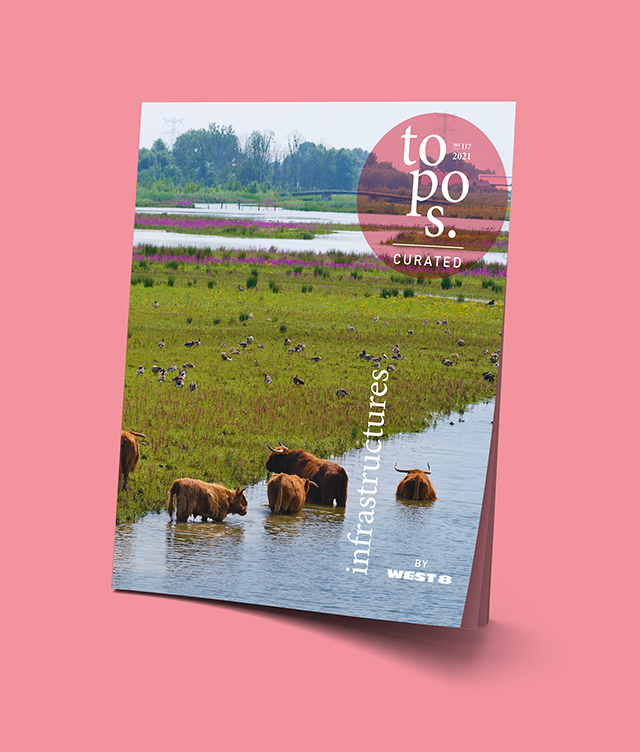

topos 117: infrastructures
This issue marks the first time topos has been curated by an individual office. The office with whom we dared to engage in this experiment is none other than West 8 – where roughly 70 landscape architects, architects, urban designers and engineers are designing and shaping landscapes all over the world from their offices in The Netherlands, Belgium and North America. West 8 has taken on great things with this issue. “Within this edition of topos we wish to change the perspective, open things up by collecting a broad view of multidisciplinary thoughts about the beauty of infrastructure, to spaces where infrastructure is an invisible but necessary background layer, and moreover, where there would be no space to understand things at all without this additional layer. We are introducing a new manifesto for designing a 21st city – a cultivated, landscape-forward, open, vibrant, ecological and responsive city: Clover21. These elements are the new trigger for designing and planning cities: This is infrastructure.”, says Adriaan Geuze, co-founder of West 8. Get a free preview of our current issue – enjoy the read.
about topos
topos - The International Review of Landscape Architecture and Urban Design - focuses on landscape architecture as well as increasingly on architecture and urban planning. It sees itself as an interdisciplinary think tank aimed at addressing the challenges urban areas will face in future. The professional magazine strives to inspire planning practitioners, urban experts and professionals who shape the cities of tomorrow. Every issue of the periodical, that is published quarterly, is dedicated to a different topic and deals with a broad array of projects and planning work in countries all over the world.


Eindhoven: The 21st Century City
Eindhoven has kept its position as a world leader across industrial revolutions, from pioneering light bulb production, to the invention of the cassette tape, VHS, CDs and DVDs. Today, the southern Dutch city is Europe’s leading innovation cluster in nanotechnology and smart technology, including the Internet of Things (IoT), Big Data, 5G, and Artificial Intelligence. How has as small Dutch town achieved such innovative success? Unequalled in its unique mix of creativity, landscape, history and culture, we feature the design capital of the Netherlands across several articles of this edition of topos as the perfect CLOVER21case study city. Read more in the print issue or the ePaper.


“We unveiled so many traces and layers of history”
Established in 1974 and located along the Niagara Gorge, Artpark is a cultural institution that many Americans remember as a lively and vibrant cultural venue. However, over the years Artpark funding and visitorship waned, and today only few people come to the site. By contrast, the Niagara Gorge, boasting 8 million visitors per year, is only five minutes away. With the aid of the “Masterplan Power Artpark 2030”, Artpark shall be reinvigorated by reconnecting to its 1970’s roots as a key location for the intersection of art, performance and community. We spoke with architect Florian Idenburg, whose office SO-IL developed the Masterplan in cooperation with West 8 and Charcoalblue, a theatre, acoustics and digital design studio. They created a roadmap for the future of a piece of infrastructure in upstate New York by bringing the traces of the past to the present. Read more about it in the print issue or the ePaper.


Como la Espina de Pescado: Infrastructure and the (un-)intended Consequences of Speculation
The Highway Marginal de la Selva, planned in 1963 to link the Amazon regions of Bolivia, Peru, Ecuador, Colombia and Venezuela, promises the economic integration of regions long considered at the peripheries of the state. However, its construction has coincided with deforestation and land use conversion. Tracing the history of this road, as well as current patterns of land use that follow it, reveals how even seemingly remote infrastructures are entangled in ongoing processes of speculation. This very speculation can hold both promise and peril for addressing ecological and social injustice.
Read more in the print issue or the ePaper.
